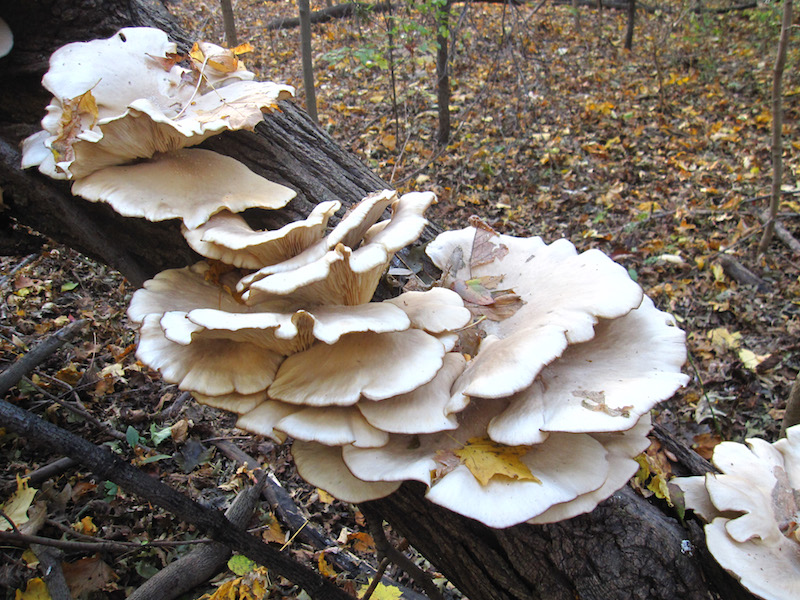One snappy day last October my husband and I had some things to talk over so we went for a walk. Instead of finding solutions, we found mushrooms, which may amount to the same thing.
On the way to Prospect Park, we stopped at Blue Apron in Park Slope for picnic fodder: ham and a baguette. At the cash register I begged for a few bags for the mushrooms I hoped might be waiting in the woods. On a November foraging tour with Steve Brill the year before, I’d scored an oyster mushroom and I had a feeling that we might get lucky again today.
“Plastic is not good for mushrooms!” said the friendly and well-informed guy behind the till, handing me paper sacks. “Be careful…” added a customer.
Once in the color-turning woods we scanned every tree and log. We’d begun to give up hope when I froze. “Mushroomsssss,” I hissed, pointing and trembling like a bird dog at a dead fallen tree a ways off the path. We waited for one of the solitary men who frequent this part of the woods to pass, then stepped into the leaf litter.
The pale and unmistakable oyster mushrooms (Pleurotus ostreatus) were stacked thickly on the log like undersea fans beneath the falling yellow leaves. With a sharp pocketknife we sliced off about a third of what we found—there were far more than we needed for a meal, and my mother had taught me to leave some behind: for other foragers, for regrowth, for the forest.
On the way home, sacks bulging, we stopped in at Blue Apron again to give them some mushrooms as payment for the bags. No one took us up on the offer (not that I blame them: beware a woman bearing mushrooms), but one staffer said she had recently found chicken of the woods mushrooms in Prospect Park. Hmm. At home, I sliced and sautéed our prize in sweet butter with a clove of garlic, some lemon juice and a splash of cream. Pepper, pappardelle and a delicate rain of grated Parmigiana made a cool-weather feast. The next night I fried up two of the large white fans as steaks, to accompany an oyster mushroom risotto.
I returned to the woods in November with my friend Ellen Zachos, an experienced mushroom hunter. Our goal this time was hen of the woods, or maitake (Grifola frondosa), rumored to appear here in the last forest in Brooklyn. They grow at the base of oaks and appear year after year in the same spot.
Amid the tall, old trees and whispering leaves we found a wig-wam, Pink Berry cigar wrappers, Dorito bags, wet wipes; juice, rum and vodka bottles; and many condom wrappers and their former contents.
Welcome to Prospect Park.
After a few minutes under the brightly leafed trees, Ellen pounced. The first hen of the woods, still distinctively frilly and coiffed like an image-conscious ash-blond hedgehog, was a little dry at the edges. Later Ellen made a broth from her share, and I a finely chopped base for a pizza. The flavor was strong and intensely, addictively mushroomy. The second, football-size hen was younger, softer, more dewy when touched. The curls lay flat, rather than pointing in all directions. This one made a memorably good chicken cacciatore.
My mushrooming had acquainted me with the sad city litter that festoons this forest’s floor, and for every mushroom clump I found, there seemed to be a mountain of trash. This juxtaposition of the delicious and the insalubrious inspired me to form the Prospect Park Litter Mob, a volunteer group that meets every other Tuesday to pick up litter and perform woodland restoration. During one cleanup, I spotted a picture-perfect chicken of the woods (Laetiporis cincinnatus), where it grew a few inches from used condoms and soiled tissue. Torn between desire and distaste, I left it.
But I will be back in these clearer, colder months, looking for high-growing oysters, whose habit seems to keep them literally above the fray. I have seen them appear overnight on the same logs in summer but in the sticky months they soon grow spongy—and attracting bugs and flies, they’re often riddled with critters. The cold weather keeps them clean and beautiful. Perhaps, one day, the woods will be clean and beautiful, too.
I have since found oyster mushrooms near and far: beside a mountain pool in Cape Town, South Africa; in the woods of Pennsylvania; on a tree stump on Congress Street—peed on serially by dogs with oblivious owners—and growing out of a wooden planter in a garden on a sixth-floor terrace. Chances are, there is an oyster mushroom nearer to you than you think. Proceed hopefully.
Read before eating: Some wild mushrooms can kill you. If you are new to mushroom foraging, do not rely solely on book or online identification. Only eat wild mushrooms that have been identified by an experienced mushroom hunter, in person. Always make a spore print. Even if verified edible, eat a small piece and wait 24 hours before eating any more. Symptoms of life-threatening poisoning usually only appear after many hours or even days.
Eating off the (forest) floor. The author was inspired to make Oyster mushroom risotto—and to found a litter mob.
Photo credit: Marie Viljoen.



